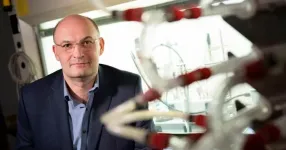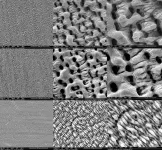(Press-News.org) BATON ROUGE – When faced with multiple food options and ultimately choosing one, the factors of that decision-making process may be more physiological than previously assumed. A group of scientists led by Pennington Biomedical Research Center’s Dr. Christopher Morrison recently discovered that the hormone fibroblast growth factor 21, or FGF21, plays an influential role in brain reward mechanisms like those involved in dietary choices.
The discovery was announced in the research team’s recent paper titled “FGF21 acts in the brain to drive macronutrient-specific changes in behavioral motivation and brain reward signaling,” which was published in the January 2025 issue of the journal Molecular Metabolism. The study data indicate that the FGF21 hormone acts on the brain to induce a protein-specific appetite by enhancing the reward value of foods that contain protein.
“What's fascinating is that this isn't just general hunger – it's a very specific appetite for protein,” said Dr. Morrison, Associate Executive Director of Basic Science at Pennington Biomedical. “When protein is restricted, FGF21 acts in the brain to flip a molecular switch that makes protein-rich foods more rewarding and motivates animals to seek them out. Many people struggle to maintain a balanced diet. Understanding how the body naturally regulates protein appetite could lead to better strategies for promoting healthy eating.”
In the study, animals on a low-protein diet worked especially hard for liquid protein rewards, but not carbohydrate, fatty, or sweet rewards, compared to those on a normal diet. However, if FGF21's ability to act in the brain was disrupted, this protein-specific motivation was lost.
The researchers then used a sophisticated neuroscience technique called fiber photometry to assess how nutrients activate dopamine neurons within the ventral tegmental area, or VTA, a brain region associated with reward. They discovered that protein restriction shifts the dopamine response, with carbohydrate more strongly activating dopamine neurons in control animals and protein more strongly activating dopamine neurons in protein-restricted animals. Importantly, this shift in reward signaling was lost in animals lacking FGF21.
"It's a remarkable example of how hormone signals can tune the brain's reward system to drive specific nutritional appetites," explains Dr. Morrison.
“This recent discovery demonstrates the continual journey to uncover the functions of certain genes, proteins and nutrients in our bodies while also highlighting the principal value that Pennington Biomedical delivers to the broader scientific community,” said Dr. John Kirwan, Executive Director of Pennington Biomedical. “Understanding how the brain drives specific nutritional preferences has been a long-standing challenge in metabolism research. This work exemplifies how Pennington Biomedical's integrative approach - combining molecular biology, neuroscience, and behavioral studies - can unlock complex biological mysteries. I commend Dr. Morrison and his team for this extensive study, and I look forward to the additional discoveries that will emerge because of this one.”
The FGF21 hormone is produced in the liver and has been previously recognized as a regulator of energy balance and for its role in glucose metabolism. This newly published research emphasizes its significant impact on the central nervous system.
This study was supported by grants from the National Institutes of Health and reflects Pennington Biomedical's commitment to advancing understanding of the biological mechanisms underlying nutrition and metabolism.
About the Pennington Biomedical Research Center
The Pennington Biomedical Research Center is at the forefront of medical discovery as it relates to understanding the triggers of obesity, diabetes, cardiovascular disease, cancer and dementia. Pennington Biomedical has the vision to lead the world in promoting metabolic health and eliminating metabolic disease through scientific discoveries that create solutions from cells to society. The center conducts basic, clinical, and population research, and is a campus in the LSU System.
The research enterprise at Pennington Biomedical includes over 600 employees within a network of 44 clinics and research laboratories, and 13 highly specialized core service facilities. Its scientists and physician/scientists are supported by research trainees, lab technicians, nurses, dietitians, and other support personnel. Pennington Biomedical is a globally recognized state-of-the-art research institution in Baton Rouge, Louisiana.
For more information, see www.pbrc.edu.
-30-
Media Contacts:
Joe Coussan
Pennington Biomedical Research Center
225-763-3049
Joe.coussan@pbrc.edu
Ernie Ballard
Pennington Biomedical Research Center
225-763-2677
Ernie.ballard@pbrc.edu
END
Pennington Biomedical researchers uncover role of hormone in influencing brain reward pathway and food preferences
Dr. Christopher Morrison led team in discovering regulating role of hormone FGF21 for brain reward pathways, research published in Molecular Metabolism
2025-02-25
ELSE PRESS RELEASES FROM THIS DATE:
Rethinking equity in electric vehicle infrastructure
2025-02-25
As electric vehicles (EVs) gain momentum in the fight against climate change, the conversation around public charging infrastructure is growing increasingly complex. Xinwu Qian , assistant professor of civil and environmental engineering at Rice University, is spearheading research that reimagines how and where charging stations should be deployed — ensuring that alignment with people’s daily routine and activities, beyond mere accessibility, are at the forefront.
“Charging an electric vehicle isn’t just about plugging it in and waiting — it takes 30 minutes to an hour even with the fastest charger ...
Lunar Trailblazer blasts off to map water on the moon
2025-02-25
On Wednesday 26 February, a thermal imaging camera built by researchers at the University of Oxford’s Department of Physics will blast off to the Moon as part of NASA’s Lunar Trailblazer mission. This aims to map sources of water on the Moon to shed light on the lunar water cycle and to guide future robotic and human missions.
Once in orbit, the spacecraft – weighing 200kg and about the size of a washing machine- will map the surface temperature and composition of the ...
Beacon Technology Solutions, Illinois Tech awarded grant to advance far-UVC disinfection research
2025-02-25
CHICAGO—February 24, 2025—Beacon Technology Solutions (Beacon), with collaborators at Illinois Institute of Technology (Illinois Tech), has been awarded a grant to support a novel study on how Far-UVC technology can help mitigate the spread of infectious diseases in public spaces. The grant was awarded through the Illinois Innovation Vouchers (IIV) Program, which fosters research collaborations between small- and medium-sized enterprises and Illinois’ world-class universities.
Beacon’s flagship product is a wall-mounted smart disinfection device that uses Far-UVC 222nm light, which has been shown to disinfect up to 99.99 percent ...
University of Houston researchers paving the way for new era in medical imaging
2025-02-25
New technology developed by researchers at the University of Houston could revolutionize medical imaging and lead to faster, more precise and more cost-effective alternatives to traditional diagnostic methods.
For years, doctors have relied on conventional 2D X-rays to diagnose common bone fractures, but small breaks or soft tissue damage like cancers often go undetected. More expensive and time-consuming MRI scans are not always suitable for these tasks in these detection or screening settings. Now, Mini Das, Moores professor at UH’s College of Natural Sciences and Mathematics and Cullen College ...
High-tech startup CrySyst provides quality-by-control solutions for pharmaceutical, fine chemical industries
2025-02-25
WEST LAFAYETTE, Ind. — International process systems and operation experts have launched high-tech startup Crystallization Systems Technology Inc. (CrySyst) to streamline processes used by companies in the pharmaceutical and fine chemical industries.
CrySyst’s quality-by-control (QbC) framework addresses crystallization monitoring, modeling and control. The framework is based on research published in the April 15, 2020, and Oct. 5, 2021, issues of the journal Crystal Growth & Design and the Sept. 22, 2022, issue of the journal Industrial & Engineering ...
From scraps to sips: Everyday biomass produces drinking water from thin air
2025-02-25
Discarded food scraps, stray branches, seashells and many other natural materials are key ingredients in a new system that can pull drinkable water out of thin air developed by researchers from The University of Texas at Austin.
This new “molecularly functionalized biomass hydrogels” system can convert a wide range of natural products into sorbents, materials that absorb liquids. By combining these sorbents with mild heat, the researchers can harvest gallons of drinkable water out of the atmosphere, even in dry conditions.
“With ...
Scientists design novel battery that runs on atomic waste
2025-02-25
COLUMBUS, Ohio – Researchers have developed a battery that can convert nuclear energy into electricity via light emission, a new study suggests.
Nuclear power plants, which generate about 20% of all electricity produced in the United States, produce almost no greenhouse gas emissions. However, these systems do create radioactive waste, which can be dangerous to human health and the environment. Safely disposing of this waste can be challenging.
Using a combination of scintillator crystals, high-density materials that emit light when they absorb radiation, and solar cells, the team, led by researchers from The Ohio State University, demonstrated that ambient ...
“Ultra-rapid” testing unlocks cancer genetics in the operating room
2025-02-25
A novel tool for rapidly identifying the genetic “fingerprints” of cancer cells may enable future surgeons to more accurately remove brain tumors while a patient is in the operating room, new research reveals. Many cancer types can be identified by certain mutations, changes in the instructions encoded in the DNA of the abnormal cells.
Led by a research team from NYU Langone Health, the new study describes the development of Ultra-Rapid droplet digital PCR, or UR-ddPCR, which the team found can measure the level of tumor cells in a tissue sample ...
Mimicking shark skin to create clean cutting boards
2025-02-25
WASHINGTON, Feb. 25, 2025 – Keeping work surfaces clean during meat processing is a challenge. Bacteria from meat can attach, grow, and build up to create a biofilm that is difficult to remove, even on stainless steel surfaces used in industrial facilities. It can also aggregate, clumping together into an invisible mass that is stronger than individual cells, making it harder to kill using food-grade antibacterial surface cleaners.
In a paper published this week in Journal of Laser Applications, from AIP Publishing and the Laser Institute of America, researchers from the Hopkirk Research Institute, New Zealand Food Safety Science and Research Centre, ...
Adherence to the Mediterranean diet and obesity-linked cancer risk
2025-02-25
About The Study: The findings of this study indicate that higher adherence to the Mediterranean diet is associated with a modest reduction in the risk of obesity-related cancers, independent of adiposity measures. Further research is needed to clarify the mechanisms by which the Mediterranean diet may contribute to cancer prevention.
Corresponding Author: To contact the corresponding author, Inmaculada Aguilera-Buenosvinos, PhD, email iaguilerabuenosvinos@gmail.com.
To access the embargoed study: Visit our For The Media website at this link https://media.jamanetwork.com/
(doi:10.1001/jamanetworkopen.2024.61031)
Editor’s Note: Please see the ...
LAST 30 PRESS RELEASES:
New study shows how the spleen helps the immune system accept a transplant
New Mayo Clinic study advances personalized prostate cancer education with an EHR-integrated AI agent
Researchers identify novel therapeutic target to improve recovery after nerve injury
Microbes in breast milk help populate infant gut microbiomes
Reprogramming immunity to rewrite the story of Type 1 diabetes
New tool narrows the search for ideal material structures
Artificial saliva containing sugarcane protein helps protect the teeth of patients with head and neck cancer
Understanding the role of linear ubiquitination in T-tubule biogenesis
Researchers identify urban atmosphere as primary reservoir of microplastics
World’s oldest arrow poison – 60,000-year-old traces reveal early advanced hunting techniques
Bristol scientists discover early sponges were soft
New study uncovers how rice viruses manipulate plant defenses to protect insect vectors
NSF–DOE Vera C. Rubin Observatory spots record-breaking asteroid in pre-survey observations
Ribosomal engineering creates “super-probiotic” bacteria
This self-powered eye tracker harnesses energy from blinking and is as comfortable as everyday glasses
Adverse prenatal exposures linked to higher rates of mental health issues, brain changes in adolescents
Restoring mitochondria shows promise for treating chronic nerve pain
Nature study identifies a molecular switch that controls transitions between single-celled and multicellular forms
USU chemists' CRISPR discovery could lead to single diagnostic test for COVID, flu, RSV
Early hominins from Morocco reveal an African lineage near the root of Homo sapiens
Small chimps, big risks: What chimps show us about our own behavior
We finally know how the most common types of planets are created
Thirty-year risk of cardiovascular disease among healthy women according to clinical thresholds of lipoprotein(a)
Yoga for opioid withdrawal and autonomic regulation
Gene therapy ‘switch’ may offer non-addictive pain relief
Study shows your genes determine how fast your DNA mutates with age
Common brain parasite can infect your immune cells. Here's why that's probably OK
International experts connect infections and aging through cellular senescence
An AI–DFT integrated framework accelerates materials discovery and design
Twist to reshape, shift to transform: Bilayer structure enables multifunctional imaging
[Press-News.org] Pennington Biomedical researchers uncover role of hormone in influencing brain reward pathway and food preferencesDr. Christopher Morrison led team in discovering regulating role of hormone FGF21 for brain reward pathways, research published in Molecular Metabolism





